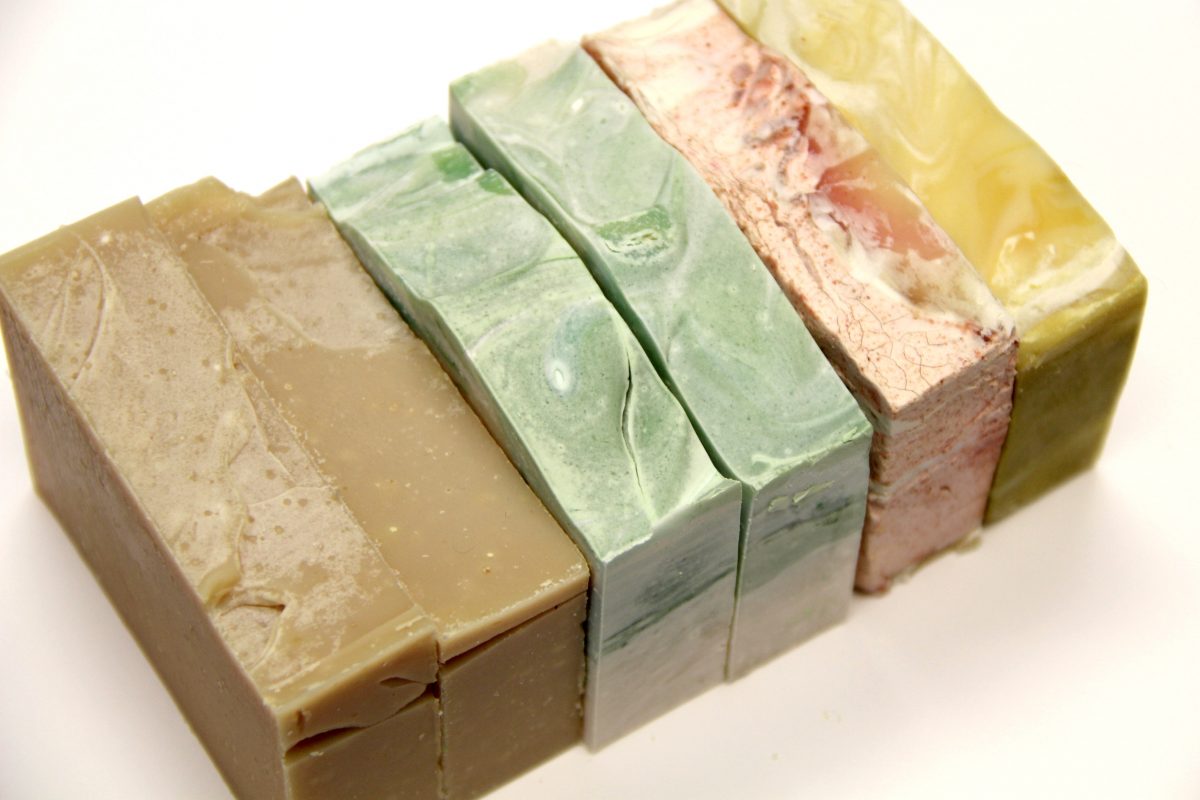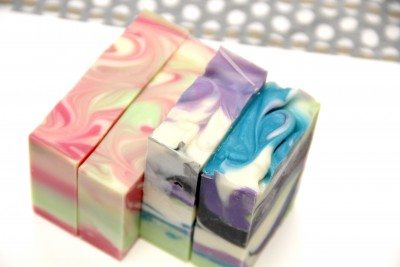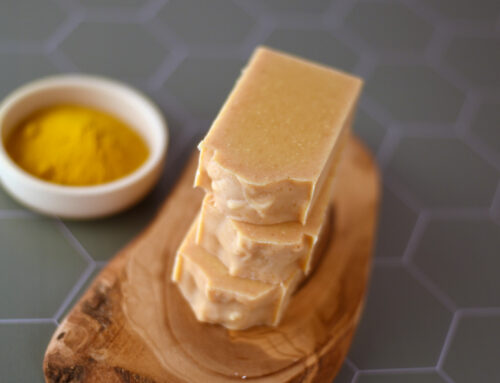Have you ever made a beautiful swirled soap only to come back to it the next day and the surface is covered with an ashy substance?
Grrrrrrrrrrrrrr
This is ash. Soda ash (commonly referred to as ash) is a pesky little problem that just about every soapmaker has encountered at one time or another. What is it? Ash is sodium carbonate. Sodium carbonate forms where un-reacted lye meets air during the time that you pour your soap until when it is saponfied 24-48 hours later. We know it is sodium carbonate if it is soluble in water (you can rinse it off) and it covers the surface of the soap that is exposed to air. If you have white dots or streaks in your soap, especially below the surface, you might have lye spots, stearic spots or something else.
If you cut your soap to soon and it hasn’t fully saponfied, you can get ash that covers the entire bar of soap, as the last tiny bit of un-reacted lye reacts to the air!
The good news about ash is two-fold. Ash is an aesthetic issue; it does not affect the effectiveness of your soap and ash is preventable.
If you do get ash, no biggy, your soap might not look as pretty and colorful below the blanket of white, but it will still clean you. To remove the ash, you can steam it, rinse it under warm water or even plane it off.
How to Prevent Ash on Soap
To prevent ash, spray your soap with alcohol. Find the highest grade of alcohol that you can find. We can get 91% Isopropyl Alcohol here. Put it into a fine mist spray bottle.
I spray my soap twice, once right after pouring and then again about 30 minutes later. That usually does the trick and prevents ash from forming.











Hi Amanda
I’ve been seaching for information about if the use of spraying alcohol on the soap makes it toxic in a way or non natural but can’t find an answer. Guess it must be because the alcohol evaporates and is no longer an issue. Please help. Muy husband has very sensitive skin.
Thank you
It evaporates, so its fine
help! Hi Amanda,
I tried making charcoal sea salt cp soap lastnight. This morning the soaps looked ashy and frothy. See pics.
What can i do to save batch?
https://photos.app.goo.gl/AvanTSUvGQdZ7OVh2
Hello. I find ash develops soaping too cool. I also think there are different types of ash. Right away is the worst and the whole batch ends up chalky, a couple days after removing the plastic wrap, which can usually be sponged away,, the kind that develops over time, and the kind from gell. It may happen from certain ingredients, too. More often with pal than lard for me. I don’t understand ash now any better than I ever have. But I do know that spraying with alcohol never does anything about it. Just doesn’t work.
I don’t usually get ash on my larger molded soaps. I do spray them twice & sometimes 3 times (30 minutes apart). But my smaller 1.5-2.0 oz molds get a thick covering of ash despite the RA. I primarily use the smaller soaps for samples or gift sets. And I just plane the ash off the smaller soaps. There was a period of about 2 weeks that I got ash on everything. I finally realized I had poured the 70% RA into my spray bottle instead of the 91%.
Hi Amanda. I find that, yes, it seems to be a surface ratio thing. My soaps that i pour into deep square silicone molds don’t have ash, and the soap I pour into shallow wide squares have heaps of ash. And.. the really small guest soaps in bee and bug shapes have heaps of ash and are chalky. So, even if the recipe is the same for all these molds, this is the outcome.
Hi Abigail, I had tried the formula .and the soap turns out beautiful swirls…really fantastic..thank you so much for your guidance and recipe..
hi Amanda, I had a question about Tea Tree essential oil. I made a small batch of soap using 40 oz. of Olive oil and 10 0z. coconut oil. I added 1 fl. Tea Tree oil. That may have been to much but will the soap still be ok to use?
Thanks Mary
Hi Mary! Yes, you can still use it. I use about .5 oz of tea tree per pound of soapmaking oils. So for 50 oz. of soapmaking oils, I would use about 1.5 oz. of tea tree oil.
Heyyy, do you ever conduct a soap making class in the Dallas area?
Not anymore! Check out http://www.wanderingthistlestudio.com in Bedford. 🙂
Hello Amanda! Thanks for the feedback. In Brazil, isopropyl is used for electronics cleaning, by the power of evaporation. The smell is very strong, I thought it would go away, It would be another type of alcohol? Perhaps grain alcohol? I’m sorry to bother you with this issue, but you could post a picture of isopropyl alcohol you use? Especially with the specifications and components, so I try to find something similar in brazil. Thank you very much.
Ash has been a big problem for me this fall/winter. The less humidity (I live in the Rockies at 8900 ft) the more ash, which goes against everything that I’ve read. I’ve tried soaping hotter, cooler, different oils. It seems like if the soap gels the ash is heavy. If not, it’s good. I’ve been trying your slow tracing palm free recipe (I have always chosen not to use palm products) with olive oil, coconut oil, rice bran oil, avocado oil, and Shea. It seems to go to gel phase lightning fast and ash like crazy. Am I doing something wrong? Soaping at 95-110 degrees. Going to light trace then adding colorants and hand stirring in. Stays loose long enough to pour complicated swirls. Then boom gel phase and ash. Any advice would be greatly appreciated!
Gosh, I’m not sure. Most of my batches don’t gel here. I would try soaping cooler. I’m usually room temp on lye solution and 90 and below for oils.
Thanks! I will try it. Most of my soap doesn’t gel either so this is all a new phenomenon for me! I love your blog. Thanks for all of the advice.
I spray my tops with ra and that’s prevented ash on top. However, I do sometimes get ash on the sides (faces of soap are also ok). I unmold 20-24 hours after pouring, but wait days to cut. I’m thinking that I should either wait longer to unmold or I should spray the sides of the loaf with ra. What do you think Amanda?
I think you could spray the sides after unmolding for sure. That should help the ash on the edges.
Thanks!
Hmmm, I had a couple of batches that had tha ash on it and I just cut it off, but will give the 91% alcohol a try. Thank you for the info.
Hello! Amanda, the isopropyl alcohol has a very strong smell and damaged my bar of soap. I had to throw away.
Hi Renato! Really? I’m sorry to hear that you had issues with isopropyl. I’ve been using this for 8 years now and haven’t ever had it overpower my soap. It will evaporate away. That is the nature of alcohol.
Hello Amanda! Thanks for the feedback. In Brazil, isopropyl is used paralimpeza of electronic equipment, by the power of evaporation. The smell is very strong, I thought it would go away, It would be another type of alcohol? Perhaps grain alcohol?
Hello Amanda! Thanks for the feedback. In Brazil, isopropyl is used for electronics cleaning, by the power of evaporation. The smell is very strong, I thought it would go away, It would be another type of alcohol? Perhaps grain alcohol?
Hi Amanda, I’m sorry to bother you with this issue, but you could post a picture of isopropyl alcohol you use? Especially with the specifications and components, so I try to find something similar in brazil. Thank you very much.
Can you view this image? https://lovinsoap.com/wp-content/uploads/2015/12/IMG_2184.jpg
Thank you very much!!!